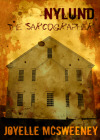Nylund the Sarcographer
To understand the world through its surfaces is sarcography, according to the titular character of Joyelle McSweeney’s Nylund the Sarcographer. The term “sarcography” breaks down to mean “flesh writing,” and is somewhat expanded to include rain, reading, one’s children or the idea of them, the senses, possibly more. McSweeney does not marry poetic and prosaic language – rather, she brings them together in a collision of semi-fabulist writing. Chapter 1, “I’m a Lug,” begins, “What else could I be as I walked down the street but a sarcographer of raining. I had to build a cask around it, built like itself.”
To understand the world through its surfaces is sarcography, according to the titular character of Joyelle McSweeney’s Nylund the Sarcographer. The term “sarcography” breaks down to mean “flesh writing,” and is somewhat expanded to include rain, reading, one’s children or the idea of them, the senses, possibly more. McSweeney does not marry poetic and prosaic language – rather, she brings them together in a collision of semi-fabulist writing. Chapter 1, “I’m a Lug,” begins, “What else could I be as I walked down the street but a sarcographer of raining. I had to build a cask around it, built like itself.”
The writing forms dips and peaks of prose, descending into obscurity and deliberate misspellings, then arcing up unexpectedly into a concrete, more readily accessible narrative. At times, the ordinary devolves into a poetic metaphysics, such as when Nylund, in a memory of his now missing twin sister Daisy, recalls sitting with her, looking through a pack of trading cards:
I held up each of the cards in turn and she flicked them away, over my shoulder and between the white rungs of the fence. They must have settled in the turned earth behind me. Now we were just looking at each other. An earth burial for the robots. Diet of worms. I had a bad taste in my mouth. The vein-hued and the colorless grubs rotoring the soil to get at the cardboard instincts. Wrong stuff in my wiring. Gummed paper guts. Play-brite vinyl sheathing my still copper blood.
Nylund fuses himself with the things around him, in this case with discarded trading cards. His body becomes, itself, a cask housing cardboard offal. His mind, too, is susceptible to such effects – the mind is, after all, something to be written upon: “Nylund felt his mind itself stretch and bend in sarcography.”
It may come as no surprise, then, that Nylund’s mind is split. Dualities abound, found in the language, split between poetry and prose, in his idea of selfhood, represented by his physical twin sister, Daisy, and the twin-ness inherent in his thinking: “If only we could twin our behavior to oppositely arrive.” Twinhood, it seems, is the spark that led to Nylund’s title; twins often have ways of communicating that confound those in the singular, and is sometimes described as a sort of telepathy. “Sarcographic development: telepathic surgery” would seem to point to this theory. But where there is twinning, there is by definition a sort of split, and for Nylund it shows up in instances of substitution (paraphasia) of one word for another (the “name” of the neck for the “nape”) and so on.
Nylund’s perceptions seem sometimes skewed or inverted. People, things, are expelled, extruded, rather than leaving on their own free will. An egg does not break, but rather, “The yolk exerts itself outwards,” and people do not simply leave a building, instead, “Silverbuttoned and then trenchcoated men emitted from the house.” Empty spaces, negatives, are everywhere, and this too seems part of the nature of sarcography: “On the lintel, numbers had fallen away and left pale eidolons, each empty space punched with a nailhole which asterisked the building.”
Nylund is a sort of schizophrenic modern-day version of Bartleby the Scrivener. Like that other fictional character, a man who was rendered immobile by his quirks and preferences, Nylund often displays an over-attentiveness to empty spaces and objects of no consequence. As he narrates what is supposed to be the story of his involvement in a murder plot and something involving the absence of his twin sister, his sarcographic nature leads him to envelop scene, setting and narrative into the scripting of his own mind.
Joyelle McSweeney has not only created a unique concept – that of sarcography – she has illustrated it memorably with a masterful redefinition of what constitutes prose, and created a character who is the very embodiment of writing, reminding us of how flexible the narrative form can be.





